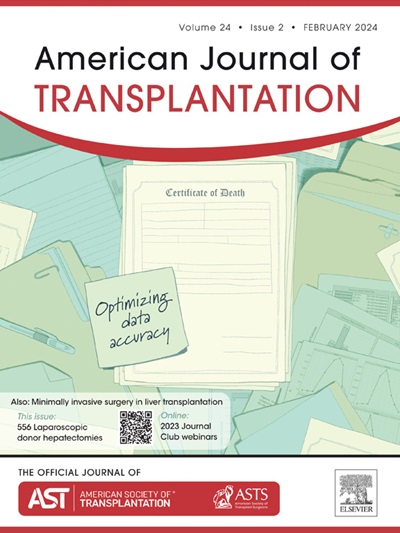器官采购组织绩效指标稳定性评价。
IF 8.2
2区 医学
Q1 SURGERY
引用次数: 0
摘要
2020年,医疗保险和医疗补助服务中心(CMS)更新了器官采购组织(OPO)的覆盖条件,将潜在死亡捐赠者(DDP)重新定义为75岁或以下患者的所有住院死亡,其主要死亡原因与器官捐赠一致,也称为CALC(原因、年龄和地点与捐赠一致)。本研究使用来自疾病控制中心(CDC)死亡率数据(目前由CMS使用)和医疗保健研究和质量机构的州住院患者数据库(SID)的2018- 2011年数据来评估CALC的绩效指标。我们分析了年度表现变异性,比较了数据来源,并检查了CALC与CALC调整的影响,排除了有潜在禁忌症的献血者。CDC CALC分级存在显著的年度差异,每年有高达40%的opo改变分级。与CDC相比,20-43%的opo使用SID改变了CALC性能等级。此外,尽管CALC和CALC调整率相关,但11-29%的opo随着调整改变了性能等级。这些差异确定了潜在变化的机会,以创建更稳定和一致的OPO绩效指标。未来的研究,以完善这些指标,以确保他们支持目标的OPO绩效持续改善,以最大限度地提高器官捐赠和移植率是很重要的。本文章由计算机程序翻译,如有差异,请以英文原文为准。
Evaluation of the stability of organ procurement organization performance metrics
In 2020, the Centers for Medicare and Medicaid Services updated the organ procurement organization (OPO) conditions for coverage, redefining deceased donor potential as all inpatient deaths among patients aged ≤75 years with a primary cause of death consistent with organ donation, also called CALC (cause, age [years], and location consistent with donation). This study evaluates CALC performance metrics using 2018-2021 data from the Centers for Disease Control (CDC) mortality data (currently used by the Centers for Medicare and Medicaid Services) and the Agency for Healthcare Research and Quality’s State Inpatient Databases. We analyzed yearly performance variability, compared data sources, and examined the impact of CALC vs CALC-adjusted, which excludes donors with potential contraindications. There was significant year-to-year variability in CDC CALC tiers, with up to 40% of OPOs changing tiers annually. Between 20% and 43% of OPOs changed CALC performance tiers using State Inpatient Databases compared to CDC. Additionally, although CALC and CALC-adjusted rates were correlated, 11% to 29% of OPOs changed performance tiers with adjustment. These differences identify opportunities for potential changes to create more stable and consistent OPO performance measures. Future research to refine these metrics to ensure they support the goal of continuing improvement in OPO performance to maximize organ donation and transplant rates is important.
求助全文
通过发布文献求助,成功后即可免费获取论文全文。
去求助
来源期刊
CiteScore
18.70
自引率
4.50%
发文量
346
审稿时长
26 days
期刊介绍:
The American Journal of Transplantation is a leading journal in the field of transplantation. It serves as a forum for debate and reassessment, an agent of change, and a major platform for promoting understanding, improving results, and advancing science. Published monthly, it provides an essential resource for researchers and clinicians worldwide.
The journal publishes original articles, case reports, invited reviews, letters to the editor, critical reviews, news features, consensus documents, and guidelines over 12 issues a year. It covers all major subject areas in transplantation, including thoracic (heart, lung), abdominal (kidney, liver, pancreas, islets), tissue and stem cell transplantation, organ and tissue donation and preservation, tissue injury, repair, inflammation, and aging, histocompatibility, drugs and pharmacology, graft survival, and prevention of graft dysfunction and failure. It also explores ethical and social issues in the field.

 求助内容:
求助内容: 应助结果提醒方式:
应助结果提醒方式:


